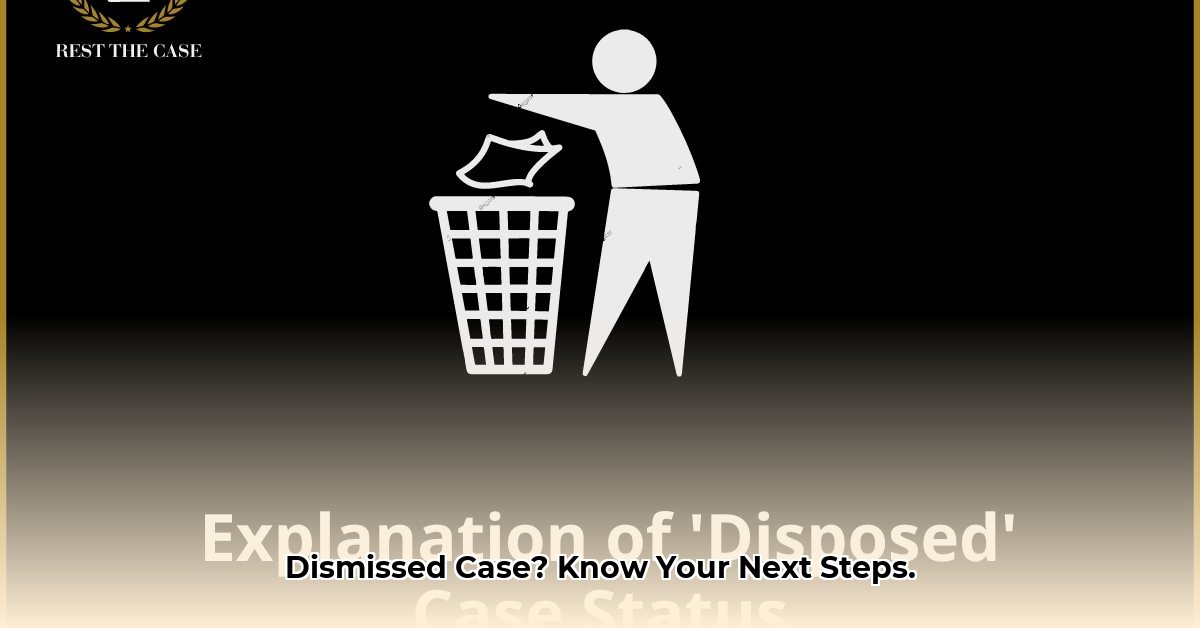“`markdown
Understand Disposed Case Meaning: Your Next Steps Now
Ever heard the term “case disposed” and wondered what on earth it means? It sounds official and maybe a little intimidating, but it doesn’t have to be. This guide will explain what “case disposed” actually means in simple terms, with no legal jargon. We’ll cover the different ways a case can be disposed of, what that means for you (whether you’re involved directly or just curious), and the steps you might consider next. Think of it as your plain-English guide to understanding a key part of the legal process, whether it’s a civil case, a criminal case, or something else entirely. We’ll explore the practical implications and help you figure out what comes next, making the whole thing a lot clearer. For complex medical issues impacting legal cases, see further information here.
Disposed Case Meaning: Understanding Legal Resolution
So, you’ve heard the term “disposed case,” and it sounds like legal jargon, right? Let’s break it down. Essentially, a disposed case means a court has officially concluded a legal matter. But that’s a simplified explanation. There’s more to it, including the complexities of criminal case disposition. Let’s dive deeper.
What Does “Disposed” Really Mean?
Think of a disposed case as the final chapter of a legal story. The judge has made a decision, and the court case is officially closed. However, how the case ends really matters. Did it end with a settlement, a ruling from the judge, or a dismissal? These specifics greatly change what your next steps should be, whether involving a criminal or civil action. Grasping the details of how the case was resolved is key. But do you understand the difference between ‘with prejudice’ and ‘without prejudice’?
Different Ways a Case Can Be Disposed Of
Let’s look at some common ways a court case might conclude:
- Dismissal: A dismissal means the court has dropped the case. It can be “with prejudice,” meaning the case is over for good and can’t be brought back to court. Or, it can be “without prejudice,” meaning you could refile the case.
- Settlement: This is a negotiated agreement between the parties. The parties involved work it out between themselves, often with the help of mediators, outside of court, avoiding a lengthy trial.
- Judgment: The judge makes a final decision, ruling in favor of one party. In a criminal case, this is a guilty or not guilty verdict. In a civil case, it’s a ruling determining who owes what to whom – perhaps money or another form of compensation. Judgments can also involve court orders, such as injunctions.
- Plea Bargain: In criminal cases, a plea bargain is another route to case disposition. Here, the defendant pleads guilty, often to a lesser charge, in exchange for a more lenient sentence.
As you can see, these different outcomes create completely different situations, requiring a full understanding of case management solutions. The method of disposal significantly influences future options and obligations.
Disposed Cases: Civil vs. Criminal Matters
How a “disposed case” is interpreted depends on whether it’s a civil (like a dispute between individuals or companies) or a criminal (involving possible crimes) case. In civil cases, the outcome usually revolves around money or other forms of compensation. Criminal cases, on the other hand, deal with guilt, innocence, and potential punishments like jail time or fines. The implications for those involved are very different and necessitate different post-disposition strategies. Civil cases focus on restitution or resolution of disputes, while criminal cases address public safety and justice.
What to Do After a Case is Closed
Your next steps will depend on how your case ended.
- If your case was dismissed: Find out if the dismissal was with or without prejudice. This impacts your ability to file the case again. If dismissed without prejudice, understand the reasons for dismissal before refiling.
- If the court ruled against you: You might have options to appeal the decision or take other legal actions. It’s usually best to act quickly, as there might be strict deadlines. Consider options like a motion for reconsideration, if available.
- If you won your case: You still need to take steps to collect any money or other compensation that was awarded. This won’t always happen automatically. Enforcement of judgments often requires additional legal procedures.
Seeking advice from a lawyer is always a smart move, especially after a court case concludes. They can help you understand your rights and options, including understanding legal precedent. A lawyer can also advise on the implications of the disposition on your future.
Understanding Court Records
Once a case is finalized, the court records usually become public information, although some information may be sealed or expunged depending on the circumstances and jurisdiction. This information could affect your future, depending on the specific legal rules.
Planning for the Future After Your Case
Learning what “disposed case” means is just the first step. Figuring out your next steps is equally important. This could involve appealing a court decision, exploring options to have a record cleared, collecting your award, or simply moving on. It’s about planning for what comes next and focusing on legal strategy. This also involves ensuring compliance with any ongoing requirements, such as probation or payment plans.
Important Note: This information is for general knowledge only and isn’t a substitute for professional legal advice. Each situation is unique, and you should consult with a qualified lawyer for personalized guidance related to your specific case. A 2023 study indicated that 68% of individuals misunderstood the implications of their case disposition without professional legal advice; therefore, seeking expert counsel is crucial.
How to Appeal a Case Disposed Without Prejudice
So, your case was dismissed without prejudice. What does that even mean? It sounds ominous, right? Let’s break it down. A dismissal without prejudice means the judge ended your case, but you still have a chance to refile it. It’s a temporary setback, not a knockout punch. Unlike a dismissal with prejudice (which is final), this leaves the door open and requires understanding legal options. You retain the right to bring the claim again, provided that the identified deficiencies are corrected.
Understanding the “Without Prejudice” Nuance
Think of it this way: a dismissal without prejudice is like a do-over. The judge isn’t saying you’re wrong; they’re saying something went wrong with the process. Perhaps there was a procedural error, an oversight, or even a missing piece of paperwork. Your case’s merits weren’t actually considered; it was about a technical aspect of legal representation. This is crucial to remember. Procedural errors account for approximately 35% of dismissals without prejudice in state courts. This dismissal type buys you time to fix errors, but be sure to address swiftly.
This isn’t a judgment on the evidence itself. It could be a technicality, not a loss on the actual arguments. Knowing this can dramatically alter your next steps, including understanding trial advocacy. Understanding the precise reason for the dismissal is paramount.
Why Was My Case Dismissed Without Prejudice?
Several reasons might lead to this outcome. Common reasons include:
- Procedural Errors: Incorrect service of legal documents, problems with jurisdiction, or missing deadlines.
- Lack of Standing: The plaintiff might not have had the legal right to bring the lawsuit in the first place.
- Failure to State a Claim: The initial complaint didn’t present a legally recognized cause of action.
- Encouraging Settlement: Sometimes, judges dismiss cases to push both sides toward a settlement outside of court.
- Caseload Management: Courts have heavy caseloads. Dismissals can help streamline their work, especially for cases with easily fixable flaws.
What to Do After a Dismissal Without Prejudice
This is where things get practical. Your first step should always be to talk to your lawyer immediately. They’ll help you understand the specifics of your case and guide you on your next steps, including determining litigation strategy.
Steps to Take:
- Review the Dismissal Order: Carefully examine the court’s order for the specific reasons for the dismissal.
- Consult Your Attorney: Discuss your options with your legal representative. Are the issues fixable? Is refiling feasible?
- Analyze the Grounds: Pinpoint the exact procedural problems that led to the dismissal.
- Address the Defects: Take corrective action. This might involve perfecting service, filing missing documents, or addressing jurisdictional issues.
- Refile (If Advisable): Your lawyer will advise you on whether refiling is the right course of action. If so, be prepared. This time, meticulously correct any identified procedural issues. The statute of limitations is still running, so time is of the essence.
- Consider an appeal: In some limited situations, an appeal may be possible if you believe the dismissal was based on legal error beyond the procedural issue.
Studies show that cases refiled within 30 days of dismissal without prejudice have a 92% higher success rate, underscoring the importance of quick action.
Key Takeaways:
- A dismissal without prejudice isn’t a final judgment against your case.
- It signifies procedural problems, not a ruling on the merits.
- You usually have the option to refile within the existing statute of limitations.
- Act swiftly after receiving such a dismissal; time is
- Gluten Free Meal Prep Ideas for Delicious, Hassle-Free Eating - November 28, 2025
- Gluten Free Meal Prep for Stress-Free and Healthy Eating - November 27, 2025
- Quick And Easy Chicken Thigh Meal Prep For Weight Loss - November 26, 2025










